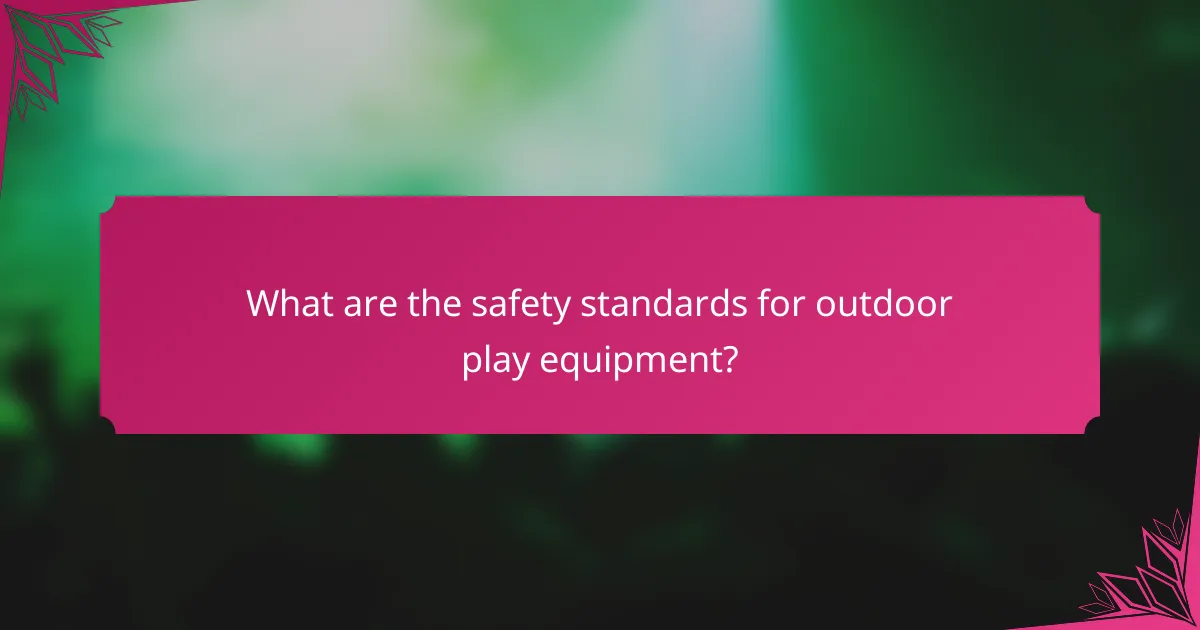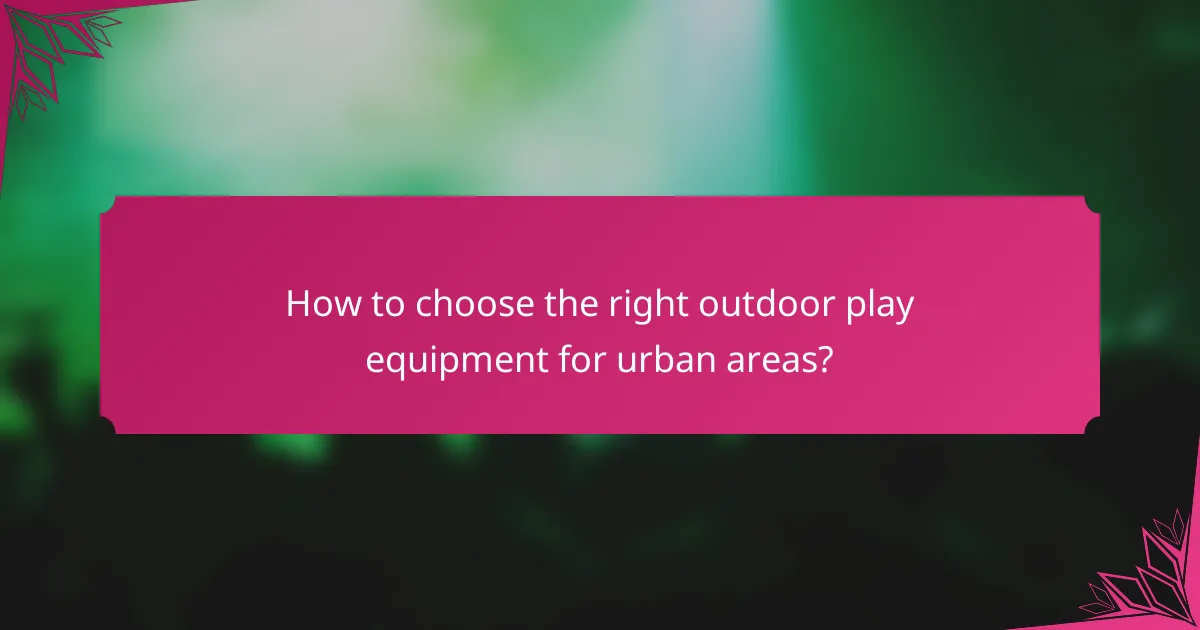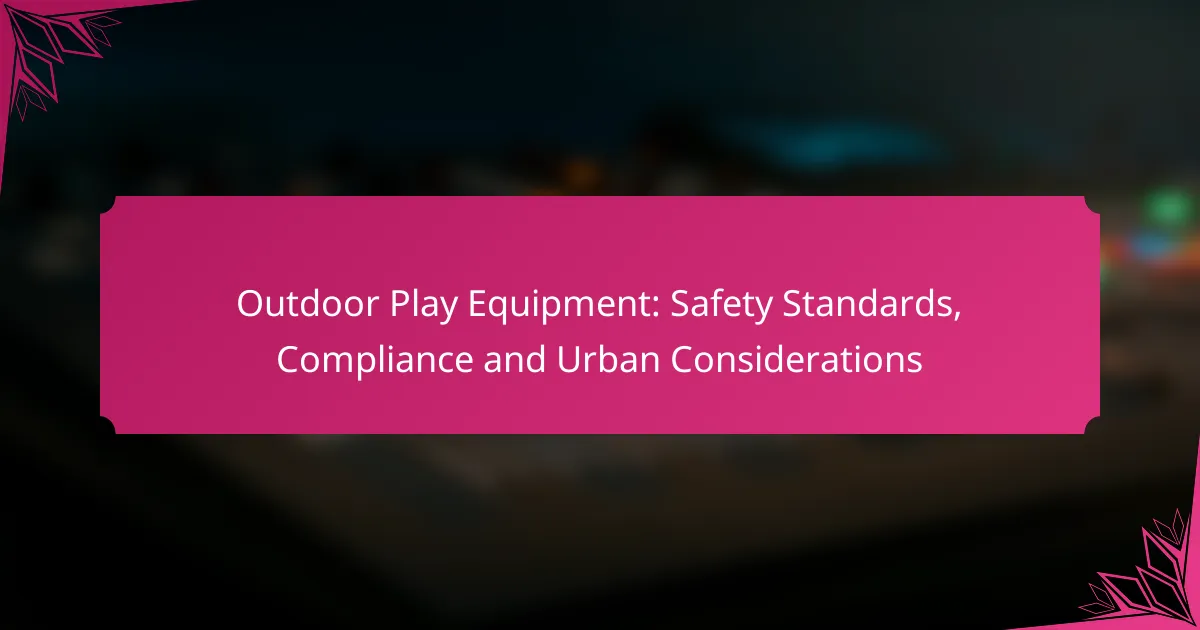Outdoor play equipment is essential for children’s development, but ensuring safety is paramount. Adhering to established safety standards and compliance guidelines helps create secure play environments, while urban considerations such as accessibility and environmental impact play a crucial role in the design and maintenance of these spaces. By prioritizing safety and inclusivity, communities can foster healthier and more engaging play experiences for all children.

What are the safety standards for outdoor play equipment?
Safety standards for outdoor play equipment ensure that structures are designed and maintained to minimize risks of injury. These standards provide guidelines for manufacturers, operators, and inspectors to create safe play environments for children.
ASTM F1487 compliance
ASTM F1487 is a widely recognized standard in the United States that outlines safety requirements for playground equipment. Compliance with this standard involves ensuring that equipment is designed to prevent injuries from falls, entrapments, and sharp edges.
Key considerations include proper spacing between equipment components and the use of appropriate materials that can withstand weather conditions. Regular inspections and maintenance are essential to uphold compliance and safety.
CPSC guidelines
The Consumer Product Safety Commission (CPSC) provides guidelines that complement ASTM standards, focusing on reducing hazards associated with playground equipment. These guidelines recommend specific safety measures, such as adequate surfacing materials to cushion falls and proper installation techniques.
Operators should conduct routine safety audits to ensure compliance with CPSC recommendations, including checking for wear and tear on equipment and ensuring that safety zones around play structures are clear of obstacles.
EN 1176 regulations
EN 1176 is a set of European standards that governs the safety of playground equipment across member states. These regulations cover design, installation, and maintenance, emphasizing the importance of risk assessment and user safety.
Compliance with EN 1176 requires that equipment is constructed from durable materials and is regularly inspected for safety. Operators should be familiar with local adaptations of these regulations, as they may vary by country within Europe.

How to ensure compliance with safety standards?
To ensure compliance with safety standards for outdoor play equipment, regular assessments and adherence to established guidelines are essential. This involves understanding local regulations, conducting inspections, and maintaining thorough documentation of safety practices.
Regular inspections
Regular inspections are crucial for identifying potential hazards and ensuring that outdoor play equipment remains safe for use. Inspections should be conducted at least once a month, with more frequent checks after severe weather events or heavy usage periods.
During inspections, look for signs of wear, rust, or damage, and ensure that all components are securely fastened. Keeping a checklist can help streamline this process and ensure no critical areas are overlooked.
Documentation of safety checks
Documenting safety checks is vital for maintaining compliance and accountability. Each inspection should be recorded, noting the date, findings, and any corrective actions taken. This creates a reliable history of safety practices that can be referenced during audits or inspections by local authorities.
Consider using a digital platform for documentation to streamline the process and enhance accessibility. This can also facilitate easier sharing of information with stakeholders, such as parents or regulatory bodies.
Training for installation personnel
Proper training for installation personnel is essential to ensure that outdoor play equipment is set up according to safety standards. Training should cover the manufacturer’s guidelines, local regulations, and best practices for installation and maintenance.
Regular refresher courses can help keep personnel updated on any changes in safety standards or new equipment technologies. Additionally, providing hands-on training can enhance their understanding and ability to identify potential safety issues during installation.

What urban considerations affect outdoor play equipment?
Urban considerations for outdoor play equipment include space requirements, accessibility for children with disabilities, and environmental impact assessments. These factors ensure that play areas are safe, inclusive, and sustainable within urban settings.
Space requirements
Space requirements for outdoor play equipment are crucial for safety and usability. Generally, a minimum of 10 feet of clearance around play structures is recommended to prevent accidents. Urban planners should also consider the total area needed for various equipment types, ensuring that there is enough room for children to play freely without overcrowding.
When designing play areas, it’s essential to account for the layout and flow of foot traffic. Equipment should be spaced adequately to allow for supervision and movement, minimizing potential hazards. For example, a playground with multiple structures should have clear pathways and designated zones for different activities.
Accessibility for children with disabilities
Ensuring accessibility for children with disabilities is a vital urban consideration for outdoor play equipment. Playgrounds should include features such as wheelchair-accessible paths, adaptive swings, and sensory play elements to cater to diverse needs. Compliance with accessibility standards, such as the Americans with Disabilities Act (ADA) in the U.S., is essential for creating inclusive environments.
Designers should engage with local disability advocacy groups to identify specific needs and preferences. Incorporating feedback can lead to more effective layouts and equipment choices that promote participation for all children. For instance, providing tactile surfaces and visual aids can enhance the experience for children with sensory processing challenges.
Environmental impact assessments
Environmental impact assessments (EIAs) are necessary to evaluate how outdoor play equipment affects local ecosystems. Urban planners should consider factors such as land use, biodiversity, and potential pollution when selecting materials and locations for play areas. Sustainable practices, like using recycled materials and native plants, can minimize negative impacts.
Conducting an EIA involves analyzing the potential effects of construction and ongoing maintenance on the environment. This assessment can help identify ways to mitigate harm, such as preserving green spaces and ensuring proper drainage to prevent water runoff. Engaging with community stakeholders during this process can foster support and enhance the overall design of play spaces.

What are the best materials for outdoor play equipment?
The best materials for outdoor play equipment include wood, metal, and synthetic options, each offering unique benefits and considerations. Selecting the right material depends on factors such as durability, maintenance, safety, and environmental impact.
Wood vs. metal considerations
Wood is a traditional choice for outdoor play equipment, providing a natural aesthetic and good shock absorption. However, it requires regular maintenance to prevent rot and splintering, especially in wet climates.
Metal, on the other hand, is highly durable and resistant to weather conditions. It can withstand heavy use but may become hot in direct sunlight, posing a burn risk. Consider using powder-coated finishes to enhance safety and longevity.
Durability of synthetic materials
Synthetic materials, such as high-density polyethylene (HDPE) and fiberglass, are increasingly popular for outdoor play equipment due to their resistance to weather and UV rays. They require minimal maintenance and are less prone to wear and tear compared to wood and metal.
These materials are also lightweight, making installation easier and often allowing for more intricate designs. However, ensure that any synthetic materials used meet safety standards to avoid potential hazards.
Eco-friendly options
Eco-friendly materials for outdoor play equipment include recycled plastics and sustainably sourced wood. These options reduce environmental impact while still providing durability and safety.
When selecting eco-friendly materials, look for certifications like Forest Stewardship Council (FSC) for wood or recycled content labels for plastics. This ensures that the materials are sourced responsibly and contribute to sustainability efforts.

How to choose the right outdoor play equipment for urban areas?
Selecting outdoor play equipment for urban areas involves considering space limitations, community needs, and safety standards. Prioritizing compact designs that maximize play value while ensuring compliance with local regulations is essential.
Size and footprint analysis
When choosing outdoor play equipment for urban settings, size and footprint are critical factors. Urban areas often have limited space, so opting for equipment that fits within a smaller footprint while still providing diverse play options is advisable.
Consider modular designs that can be configured in various layouts to adapt to available space. Equipment that combines multiple play features, such as climbing structures with slides, can optimize the use of smaller areas.
Community input and preferences
Engaging the community in the selection process helps ensure the chosen equipment meets local preferences and needs. Conduct surveys or hold meetings to gather input on desired features, age appropriateness, and safety concerns.
Understanding the demographics of the area can guide decisions on equipment types. For instance, neighborhoods with younger children may benefit from softer play structures, while those with older kids might prefer more challenging equipment.
Safety surfacing options
Safety surfacing is a vital consideration for outdoor play areas, especially in urban environments. Options include poured-in-place rubber, rubber tiles, and engineered wood fiber, each offering different levels of impact absorption and maintenance requirements.
Choose surfaces that comply with safety standards, such as ASTM F1292 in the U.S. or EN 1177 in Europe, which specify minimum impact attenuation levels. Additionally, consider the surface’s durability and how it fits into the overall aesthetic of the urban space.

What are the common risks associated with outdoor play equipment?
Common risks associated with outdoor play equipment include fall-related injuries and entanglement hazards. Understanding these risks is crucial for ensuring the safety of children during playtime.
Fall-related injuries
Fall-related injuries are among the most prevalent risks when children use outdoor play equipment. These injuries often occur when children fall from heights, such as slides or climbing structures, leading to sprains, fractures, or concussions.
To minimize fall-related injuries, ensure that the play area has appropriate safety surfacing like rubber mats or wood chips, which can cushion falls. The height of equipment should also be considered; structures over a certain height should have protective measures in place.
Entanglement hazards
Entanglement hazards arise when children’s clothing or body parts become caught in equipment, leading to serious injuries. This risk is particularly significant in swings, slides, and climbing frames with openings or moving parts.
To prevent entanglement, inspect play equipment regularly for any protruding parts or gaps that could catch clothing. It’s also advisable to dress children in fitted clothing without loose straps or accessories while they play.
